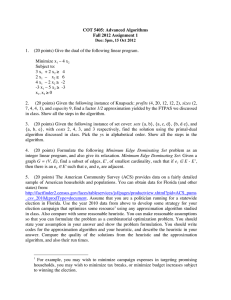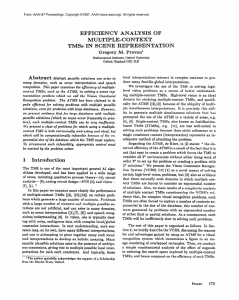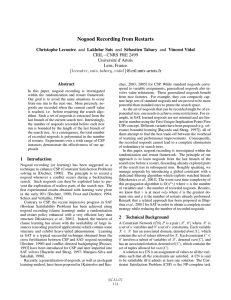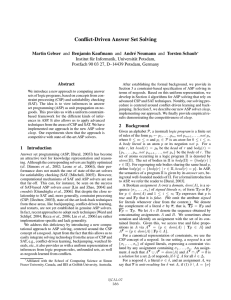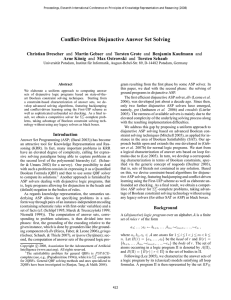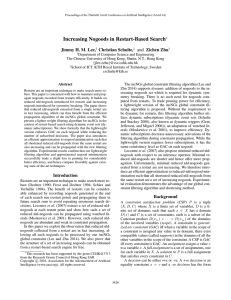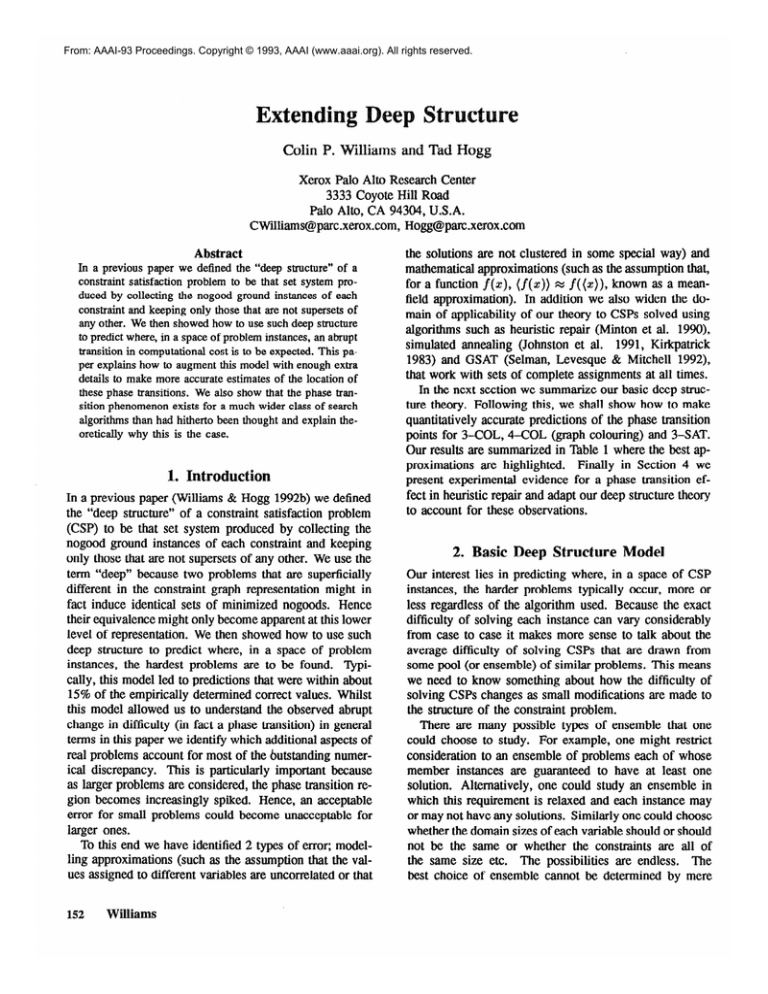
From: AAAI-93 Proceedings. Copyright © 1993, AAAI (www.aaai.org). All rights reserved.
e
en
Colin P. Williams and Tad Hogg
Xerox Palo Alto Research Center
3333 Coyote Hill Road
Palo Alto, CA 94304, U.S.A.
CWilliams@parc.xerox.com, Hogg@parc.xerox.com
Abstract
In a previous paper we defined the “deep structure” of a
constraint satisfaction problem to be that set system produced by collecting the nogood ground instances of each
constraint and keeping only those that are not supersets of
any other. We then showed how to use such deep structure
to predict where, in a space of problem instances, an abrupt
transition in computational cost is to be expected. This paper explains how to augment this model with enough extra
details to make more accurate estimates of the location of
these phase transitions. We also show that the phase transition phenomenon exists for a much wider class of search
algorithms than had hitherto been thought and explain theoretically why this is the case.
1. Introduction
In a previous paper (Williams & Hogg 1992b) we defined
the “deep structure” of a constraint satisfaction problem
(CSP) to be that set system produced by collecting the
nogood ground instances of each constraint and keeping
only those that are not supersets of any other. We use the
term “deep” because two problems that are superficially
different in the constraint graph representation might in
fact induce identical sets of minimized nogoods. Hence
their equivalence might only become apparent at this lower
level of representation. We then showed how to use such
deep structure to predict where, in a space of problem
instances, the hardest problems are to be found. Typically, this model led to predictions that were within about
15% of the empirically determined correct values. Whilst
this model allowed us to understand the observed abrupt
change in difficulty (in fact a phase transition) in general
terms in this paper we identify which additional aspects of
real problems account for most of the butstanding numerical discrepancy. This is particularly important because
as larger problems are considered, the phase transition region becomes increasingly spiked. Hence, an acceptable
error for small problems could become unacceptable for
larger ones.
To this end we have identified 2 types of error; modelling approximations (such as the assumption that the values assigned to different variables are uncorrelated or that
152
Williams
the solutions are not clustered in some special way) and
mathematical approximations (such as the assumption that,
for a function f(z), (f(z)) = f&c)), known as a meanfield approximation). In addition we also widen the domain of applicability of our theory to CSPs solved using
algorithms such as heuristic repair (Minton et al. 1990),
simulated annealing (Johnston et al. 1991, Kirkpatrick
1983) and GSAT (Selman, Levesque dz Mitchell 1992),
that work with sets of complete assignments at all times.
In the next section we summarize our basic deep structure theory. Following this, we shall show how to make
quantitatively accurate predictions of the phase transition
points for 3-COL, 4-COL (graph colouring) and 3-SAT.
Our results are summarized in Table 1 where the best approximations are highlighted. Finally in Section 4 we
present experimental evidence for a phase transition effect in heuristic repair and adapt our deep structure theory
to account for these observations.
2. Basic Deep Structure Model
Our interest lies in predicting where, in a space of CSP
instances, the harder problems typically occur, more or
less regardless of the algorithm used. Because the exact
difficulty of solving each instance can vary considerably
from case to case it makes more sense to talk about the
average difficulty of solving CSPs that are drawn from
some pool (or ensemble) of similar problems. This means
we need to know something about how the difficulty of
solving CSPs changes as small modifications are made to
the structure of the constraint problem.
There are many possible types of ensemble that one
could choose to study. For example, one might restrict
consideration to an ensemble of problems each of whose
member instances are guaranteed to have at least one
solution. Alternatively, one could study an ensemble in
which this requirement is relaxed and each instance may
or may not have any solutions. Similarly one could choose
whether the domain sizes of each variable should or should
not be the same or whether the constraints are all of
the same size etc. The possibilities are endless. The
best choice of ensemble cannot be determined by mere
cogitation but depends on what the CSPs arising in the
“real world” happen to be like and that will inevitably
vary from field to field. Lacking any compelling reason to
choose one ensemble over another, we made the simplest
choice of using an ensemble of CSPs whose instances are
not guaranteed to be soluble and having variables with a
uniform domain size, b.
Given an ensemble of CSPs, then, the deep structure
model allows us to predict which members will typically
be harder to solve than others. The steps required to do
this can be broken down into:
1. CSP + Deep Structure
2. Deep Structure + Estimate of Difficulty
The first step consists of mapping a given CSP instance
into its corresponding deep structure. We chose to think
of CSPs that could be represented as a set of constraints
over p variables, each of which can take on one of b
values. Each constraint determines whether a particular
combination of assignments of values to the variables are
consistent (“good”) or inconsistent (“nogood”). Collecting
the nogoods of all the constraints and discarding any
that are supersets of any other we arrive at a set of
“minimized nogoods” which completely characterize the
particular CSP. By “deep structure” we mean exactly this
set of minimized nogoods.
Unfortunately, reasoning with the explicit sets of minimized nogoods does not promote understanding of generic
phenomena or assist theoretical analysis. We therefore attempt to summarize the minimized nogoods with as few
parameters as possible and yet still make reasonably accurate quantitative predictions of quantities of interest such
as phase transition points and computational costs. As
we shall see, such a crude summarization can sometimes
throw away important information e.g. regarding the correlation between values assigned to tuples of variables.
Nevertheless, it does allow us to identify which parameters have the most important influence on the quantities
of interest. Moreover, one is always free to build a more
accurate model, as in fact we do in Section 3.
In our basic model, we found that the minimized nogoods could be adequately summarized in terms of their
number, m, and average size, Ic. Thus we crudely characterize a CSP by just 4 numbers, (p, b, m, k).
eep Structure
-+ Estimate of
Having obtained the crude description of deep structure
we need to estimate how hard it would be to solve such
a CSP. The actual value of this cost will depend on the
particular algorithm used to solve the CSP. In our original model we assumed a search algorithm that works by
caning
eter
D
1 number of variables
b
1 number of values per variable
m
1 number of minimized nogoods
k
average size of minimized nogoods
Fig.
1. A coarse description
of a CSP.
al solutions (either in a tree or a lattice) unsolution is found. However, the im
point is not so much the actual value of the cost but in
predicting where it will attain a maximum as this corresponds to the point of greatest difficulty. In Section 4 we
extend our model to cover the possibility of solving the
CSP using an algorithm that works with complete states
e.g heuristic repair, simulated annealing or GSAT which
requires a different cost measure (still related to the minimized nogoods) to be used.
To obtain a definite prediction, we defined “difficulty”
to be the cost to find the first solution or to determine
there are no solutions, C,. Analytically, this is a hard
function to derive and in the interests of a more tractable
analysis we opted to use a proxy instead that was the cost
to find all solutions divided by the number of solutions (if
there were any) or else the cost to determine there were
no solutions, which we approximated as’:
(C)/(NSo~n)
if there are solutions
otherwise
C1j
We analyzed what happens to this cost, on average,
as the number of minimized nogood ground instances,
m = flp, is increased. Note that we merely write m like
this to emphasize that the number of minimized no
will grow as larger problems are considered (i.e. as p
es). The upshot of this analysis was the prediction
t, as p ---) 00, the transition occurs where (N,.I,) = I
and so the hardest problems are to be found at a critical
value of p given by:
lnb
Pwit = - In (1 - bvk).
(2)
In other words, if all we are told about a class of CSPs
is that there are p variables (with p >> l), each variable
takes one of b values and each minimized nogood is of
size k then we expect the hardest examples of this class
to be when there are merit = ,&.dtp nogods.
‘N.B. this approximation will fail if the solutions are tightly clustered.
Constraint-Based
Reasoning
153
3. More Accurate Predictions
We have tested this formula on two kinds of CSPs: graph
colouring and k-SAT and compared its predictions against
experimental data obtained by independent authors. Qpitally this formula gave predictions that were within about
15% of the empirically observed values. The remaining
discrepancy can be attributed to one of two basic kinds of
error: First, there can be errors in the model (e.g. due to
assuming that the values assigned to different variables are
uncorrelated). Second there can be errors due to various
mathematical approximations (e.g. the mean-field approximation that (C/N,.I,)
zll (C)/(N,,h&
Int.mstWy,
graph colouring is more affected by errors in the model
whereas k-SAT is more affected by errors in the meanfield approximation. These two CSPs then will serve as
convenient examples of how to augment our basic deep
structure model with sufficient extra details to permit a
more accurate estimation of the phase transition points.
Graph Colouring
A graph colouring problem consists of a graph containing
p nodes (i.e. variables) that have to be assigned certain
colours (i.e. values) such that no two nodes at either
end of an edge have the same colour. Thus the edges
provide implicit constraints between the values assigned
to the pair of nodes they connect. Therefore, if we are
only allowed to use b colours, then each edge would
contribute exactly b nogoods and every nogood would be
of size 2, so k = 2. Plugging these values into equation 2
gives the prediction that the hardest to colour graphs occur
when &,-it = 9.3 (3-COL) and &it = 21.5 (4-COL) in
contrast to the experimentally measured values of 8.1 f0.3
and 18 f I respectively. This approximation isn’t too
bad, nevertheless, we will now show how to make it even
better by taking more careful account of the structure of
the nogoods that arise in graph colouring.
Imprecision due to Model
The key insight is to realize that in our derivation of formula 2 we assume the nogoods are selected independently.
Thus each set of m nogoods is equally likely. However,
in the context of graph colouring this is not the case because each edge introduces nogoods with a rather special
structure. Specifically, each edge between nodes u and v
introduces b minimal nogoods of the form {u = i, v = i}
for i from 1 to b, which changes, for a given number of
minimized nogoods, the expected number of solutions, as
follows.
Consider a state at the solution level, i.e., an assigned
value for each of p variables, in which the value i is used
solution, none of its subsets must be among the selected
nogoods. This requires that the graph not contain an edge
between any variables with the same assignment. This
b
excludes a total of c
with e edges, the p&bability that this given state will be
a solution is just
((3-~,:.,)
P(fcil)
= (z)
( 1
154
Williams
(3)
2
e
By summing over all states at the solution level, this gives
the expected number of solutions:
(4)
where the multinomial coefficient counts the number of
states with specified numbers of assigned values.
For the asymptotic behaviour, note that the multinomial
becomes sharply peaked around states with an equal number of each value, i.e., cd = p/b. This also minimizes the
number of excluded edges c ( “2) giving a maximum in
p( {ci }) as well. Thus the sum for ( Nsoln) will be dominated by these states and Stirling’s approximation2 can be
used to give
(5)
because the number of minimal nogoods is related to the
number of edges by m = ,Bp = eb.
With this replacement for In (N,,l,) our derivation of
the phase transition point proceeds as before by determining the point where the leading term of this asymptotic
behaviour is zero, corresponding to ( Ns oln) = I, hence:
Pcrit
=
-
blnb
In (1 - +)
(6)
which is different from the prediction of our basic model as
given in equation 2. This result can also be obtained more
directly by assuming conditional independence among the
nogoods introduced by each edge (Cheeseman, Kanefsky
& Taylor 1992). For the cases of 3 and rt-colouring,
equation 6 now allows US to predict Pcrit = 8.1 and
19.3, respectively, close to the empirical values given by
Cheeseman et al.
ci times, with 5 ci = p. In order for this state to be a
i=l
( “2) edges. With random graphs
2i.e. Inx!wxlnx-xasxt.00.
k-S AT
Empirical studies by Mitchell, Selman & Levesque
(Mitchell, Selman 8z Levesque 1992) on the cost of solving k-SAT problems using the Davis-Putnam procedure
(Franc0 & Paul1 1983), allow us to compare the predictions of our basic model against a second type of CSP.
In k-SAT, each of the ~1 variables appearing in the
formula can take on one of two values, true or false.
Thus there are b = 2 values for each variable. Each
clause appearing in the given formula is a disjunction of
(possibly negated) variables. Hence the clause will fail
to be true for exactly one assignment of values to the
k variables appearing in it. This in turn gives rise to a
single nogood, of size k. Distinct clauses will give rise to
distinct nogoods, so the number of these nogoods is just
the number of distinct clauses in the formula.
Thus, using equation 2, our basic model, with b = 2,
k = 3 predicts the 3-SAT transition to be at @crit =
5.2 which is above empirically observed value of 4.3.
However, as we show below, the outstanding error is
largely attributable to the inaccuracy of the mean-field
approximation and there is a simple remedy for this.
0.4
0.2
0
pg.
2. Behaviour of
3 (3-SAT). The
10 (dashed) and
lJ=
show the corresponding
to (l/(1 + JLrn)).
=
there are exponentially many solutions for p < &it the
first term in the above approximation must be negligible
at the true transition for large enough values of p. In this
case we can estimate ,8::?: as the value of ,0 at which
Imprecision due to Mean-field Approximation
var(Nsorn)
Cheeseman et al. observed that the phase transition for
graph colouring occurred at the point when the probability
of having at least one solution fell abruptly to zero. In a
longer version of this paper (Williams & Hogg 1992a) we
explain why this is to be expected. One way of casting
this result, which happens to be particularly amenable to
mathematical analysis, is to hypothesize that the phase
transition in cost should occur when (&)
transitions
from being near zero to being near 1. In order to es timate
this point, we consider the Taylor series approximation
(Papoulis 1990, p129):
var(Nsod
(7)
+ (1 + (N,01,))3
In figure 2 we plot measured values of ( &)
togefier
with its truncated Taylor series approximation versus p for
increasing values of ~1. This proxy sharpens to a step
function as ~1---) 00 apparently at the same point as that
reported by Cheeseman et al. Fortunately although the
truncated Taylor series approximation overshoots the true
before finally returning to a value of
v~--f
(&)
1 at high ,8, it nevertheless is. accurate in the vicinity of
the phase transition point as required and may therefore
be used. Hence, the true transition point can be estimated
as the value of p at which the right hand side of equation
7 equals 3. As the true transition point precedes the old
one (predicted using equation 2), i.e. ,8EFT < ,&it and as
(I/( 1 + Nsorn)) vs p. .for b = 2,
dark curves show em rncal data for
TEe light curves
,u = 20 (solid).
two-term Taylor series approximation
=
12 (I+
( N,oln))3.
(8)
By the same argument as that in (Williams & Hogg 1992b)
we can show,
var(Nsoln)
= (Nfol,) - (N,o~n)2
with
,
(N,“,h)= bp2 (Il)o- ‘)‘--’
r=O
The (N,26,, ) term is obtained by counting how many ways
there‘are of picking m = ,Bp nogoods of size k such that a
given pair of nodes at the solution level are both good and
have a prescribed overlap r weighted by the number of
ways sets can be picked such that they have this overlap.
Finally, this is averaged over all possible overlaps. With
these formulae the phase transition can be located as the
fixed point solution (in /3) to equation 7. For ~1= 10 or 20
this gives the transition point at ,f?= 4.4. Asymptotically,
one can obtain an explicit formula for the new critical
point by applying Stirling’s formula to equations 9 and
10, approximating equation 10 as an integral with a single
dominant term and factoring a coefficient as a numerical
integral. This gives a slightly higher critical point of
Constraint-Based
Reasoning
155
I
I
I
Basic +
corrections(7)
Table 1. Comparisons of our basic theory and various refinements thereof with empirical data obtained by other authors. The
numbers in the column headings refer to the equations used to
calculate that columns’ entries.
175:
150:
125:
loot
75:
50
2
4
6
. 8, _ . . .10
.
. 12
--
*.
14
beta
Fig. 3. Median search cost for heuristic repair as a function of
p for the case b = 3, k = 2. The solid curve, for p = 20, has
a maximum at p = 9. The dashed curve, for p = 10, has a
broad peak in the same region.
Pcrit = 4.546 and predicts the new functional form for
the critical number of minimized nogoods as m,,it =
&,.itp + const + 0 $ with const = 3.966.
0
The results for our basic model, the correlation model
(for graph colouring) and the correction to mean field
model (for Ic-SAT) are collected together in Table 1 where
the best results are highlighted.
4. Heuristic Repair Has Phase ‘Ikansition Too
The above results show that the addition of a few extra
details to the basic deep structure model allows us to
make quantitatively accurate estimates of the location of
phase transition points. However, the question of the
applicability of these results to other search methods, in
particular those that operate on complete states, such as
heuristic repair, simulated annealing and GSAT remains
open. In this section we investigate the behaviour of such
methods and show theoretically and empirically that they
also exhibit a phase transition in search cost at about the
same point as the tree based searches.
In figure 3 we plot the median search cost for solving
random CSPs with b = 3, k: = 2 versus our order parameter ,8 (the ratio of the number of minimized nogoods to
156
Williams
the number of variables) using the heuristic repair algorithm. As for other search algorithms we see a characteristic easy-hard-easy pattern with the peak sharpening as
larger problem instances are considered.
To understand this recall that heuristic repair, simulated
annealing and GSAT all attempt to improve a complete
state through a series of incremental changes. These methods differ on the particular changes allowed and how decisions are made amongst them. In general they all guide
the search toward promising regions of the search space
by emphasizing local changes that decrease a cost function
such as the number of remaining conflicting constraints.
In our model, the number of conflicting constraints for a
given state is equal to the number of nogoods of which
it is a superset. A complete state is minimal when every possible change in value assignment would increase
or leave unchanged the number of conflicts.
These heuristics provide useful guidance until a state
is reached for which none of the local changes considered give any further reduction in cost. To the extent that
many of these local minimal or equilibrium states are not
solutions, they provide points where these search methods
can get stuck. In such situations, practical implementations often restart the search from a new initial state, or
perform a limited number of local changes that leave the
cost unchanged in the hope of finding a better state before
restarting. Thus the search cost for difficult problems will
be dominated by the number of minimal points, Nminimal,
encountered relative to the number of solutions, Nsoln.
Thus our proxy is:
with
(Nmindrna~)
=
bppminimal
where
pminimal
is
the
probability that a given state (at the solution level) is
minimal. This in turn is just given by the ratio of the
number of ways to pick m nogoods such that the given
state is minimal to the total number of ways to pick m
nogoods. Of course, we should be aware that the meanfield approximation will again introduce some quantitative
error.
In figure 4 we plot this cost proxy and the meanfield approximation to it, for p = 10, b = 3, k =
2. This predicts that the hardest problems occur around
Compare this with empirical data, in figure
p = 9.5.
3. We see that heuristic repair does indeed find certain
problems harder than others and the numerical agreement
between predicted and observed critical points is quite
good, suggesting that (Nminimar/Nsoln) is an adequate
proxy for the true cost. Thus our deep structure theory
applies to sophisticated search methods beyond the tree
search algorithms considered previously.
minimized nogoods. Moreover, our experience suggests
the exact form for the proxy is not that critical, provided
it tracks the actual cost measure faithfully.
beta
4. Ratio of number of minimal points to number of
Fig.
solutions vs. /3 for the case of ,v = 10, b = 3, k = 2
(dashed curve, with maximum at ,8 = 9.5) and its mean-field
approximation (grey, with maximum at 12).
co
The basic deep struc~e model (Williams & Hogg 1992)
typically led to predictions of phase transition points that
were within about 15% of the empirically determined values. However, both empirical observations and theory
suggest that the phase transition becomes sharper the larger
the problem considered making it important to determine
the location of transition points more precisely. To this
end, we identified modelling approximations (such as neglecting correlations in the values assigned to different
variables) and mathematical approximations (such as the
mean field approximation) as the principal factors impeding proper estimation of the phase transition points. We
then showed how to incorporate such influences into the
model resulting in the predictions reported in Table 1. This
shows that the deep structure model is capable of making
quantitatively accurate estimates of the location of phase
transition points for all the problems we have considered.
However, we again reiterate that the more important result is that our model predicts the qualitative existence of
the phase transition at all as this shows that fairly simple
computational models can shed light on generic computational phenomena. A further advantage of our model
is that it is capable of identifying the coarse functional
dependencies between problem parameters. This allows
actual data to be fitted to credible functional forms from
which numerical coefficients can be determined, allowing
scaling behaviour to be anticipated.
Our belief that phase transitions are generic is buoyed
by the results we report for heuristic repair. This is an
entirely different kind of search algorithm than the tree or
lattice-like methods considered previously and yet it too
exhibits a phase transition at roughly the same place as
the tree search methods. We identified the ratio of the
number of minimal states to the number of solutions as
an adequate cost proxy which can be calculated from the
Cheeseman, P.; Xanefsky, B.; and Taylor, W. M. 1991.
ere the Really Hard Problems Are. In
@
of the Twelfth International Joint Conference on Artificial
Intelligence, 33 l-337, Morgan Kaufmann.
Cheeseman, P.; Kanefsky, B.; and Taylor, W.
Computational Complexity and Phase Transitions. In
Proc. of the Physics of Computation Workshop, IEEE
Computer Society.
France and Paul1 1983. Probabilistic Analysis of the Davis
tman Procedure for Solving Satisfiability Problems, Discrete Applied Mathematics 5:77-87.
Huberman, B.A. and Hogg, T. 1987. Phase Transitions
in Artificial Intelligence Systems, Artificial Intelligence,
33:1§5-171.
Johnson, D., Aragon, C., McGeoch L., Schevon, C., 1991.
Gptimization by Simulated Aneealing: An experimental
evaluation; part ii, graph coloring and number partitioning,
Research, 39(3):3784X5, Ma
S., Gelatt C., Vecchi M., 198
mization
ted Annealing. Science 220571
Minton S., Johnston M., Philips A., Laird P. 1990. Solving
Large-scale Constraint Satisfaction and Scheduling Problems using a Heuristic Repair Method. In Proc. AAAI-90,
pp 17-24.
Mitchell D., Selman B., Levesque H., 1992. Hard & Easy
Distributions of SAT Problems. In Proceedings of the 10th
National Confemce on Artificial Intelligence, AAAI-92,
pp459-465, San Jose, CA.
Morris P., 1992. On the Density of Solutions in
librium Points for the N-Queens Problem, In Proce
of the 10th National Confemce on Artificial Intelligence,
AAAI-92, pp428-433, San Jose, CA.
Papoulis A., 1990. Probability Bt Statistics, p129, Prentice
Hall
Selman B., Levesque H., Mitchell D., 1992. A New
Method for Solving Hard Satisfiability Problems, In Proceedings of the 10th National Confemce on Artificial Intelligence, AAAI-92, pp440-446, San Jose, CA.
Williams, C. P. and Hogg, T. 1991. Typicality of Phase
Transitions in Search, Tech. Rep. SSL-91-04, Xerox Palo
Alto Research Center, Palo Alto, California (to appear in
Computational Intelligence 1993)
Williams, C. P. and Hogg, T. 1992a. Exploiting the Deep
ture of Constraint Problems. Tech. Rep. SSL-92-24,
Xerox Palo Alto Research Center, Palo Alto, CA.
Williams, C. P. and Hogg, T. 1992b Using Deep Structure
to Locate Hard Problems, in Proc 10th National Conf. on
Artificial Intelligence, AAAI-92,pp472-477,San Jose CA.
Constraint-Based
Reasoning
157



